Reptiles
- African Rock Python
- Bibrons Stiletto Snake
- Black Mamba
- Mozambique Spitting Cobra
- Puff Adder
- Rhombic Night Adder
- Snouted Cobra
- Spotted Bush Snake
- Western Yellow Bellied Sand Snake
- Twig (Vine) Snake
African Rock Python
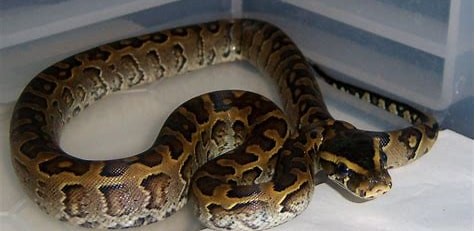
The African rock python (Python sebae) is a species of large constrictor snake in the family Pythonidae. The species is native to sub-Saharan Africa. It is one of 11 living species in the genus Python. It has two subspecies. One subspecies is found in Central and Western Africa, and the other subspecies is found in Southern Africa.Africa's largest snake and one of the six largest snake species in the world (along with the green anaconda, reticulated python, Burmese python, Indian python, and amethystine python), specimens may approach or exceed 6 m (20 ft). The southern subspecies is generally smaller than its northern relative. The snake is found in a variety of habitats, from forests to near deserts, although usually near sources of water. The snake becomes dormant during the dry season. The African rock python kills its prey by constriction and often eats animals up to the size of antelope, occasionally even crocodiles. The snake reproduces by egg-laying. Unlike most snakes, the female protects her nest and sometimes even her hatchlings.The snake is widely feared, though it very rarely kills humans. Although the snake is not endangered, it does face threats from habitat reduction and hunting. Some cultures in Sub-Saharan Africa eat this snake as delicacy which might generally be threat to its population.
Bibrons Stiletto Snake
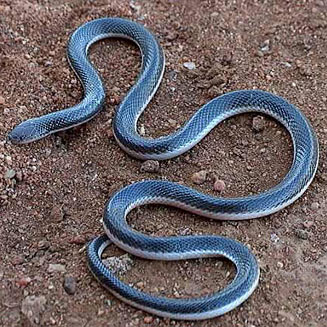
Atractaspis bibronii is a species of venomous snake in the family Atractaspididae. The species is endemic to Africa. No subspecies are currently recognized. Adults of A. bibronii average 30–40 cm (12–16 in)[2] in total length (including tail), with a maximum total length of 55 cm (21+3⁄4 in).[2] The dorsum is a uniform grey or dark brown to black colour.[2] The belly is a uniform white, or pale yellow in color, with a series of dark blotches. In specimens with a lighter belly coloration, the belly coloration may also include two or three scale rows on the flanks.The snout is prominent and subcuneiform. The portion of the rostral visible from above is as long as or a little shorter than its distance from the frontal. The dorsals are in 21 or 23 rows at midbody. The ventrals number 221-260. The anal is entire. The subcaudals number 20-23, of which all or the greater part are single (not divided) The venom of A. bibronii is highly toxic, although it is produced in very small amounts. Bites are common in some areas of Africa. Often, snake handlers are bitten who are unaware that this species is able to bite while being held by its neck. Bite symptoms usually include mild to intense pain, local swelling with occasional blistering, and necrosis and regional lymphadenopathy. In the early stages symptoms like dry throat and nausea may be present.[2] No fatalities have been recorded. However, this is a serious bite and medical treatment will need to be provided.
Black Mamba
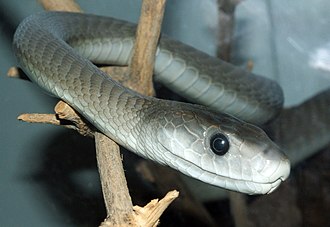
The black mamba (Dendroaspis polylepis) is a species of highly venomous snake belonging to the family Elapidae. It is native to parts of sub-Saharan Africa. First formally described by Albert Günther in 1864, it is the second-longest venomous snake after the king cobra; mature specimens generally exceed 2 m (6 ft 7 in) and commonly grow to 3 m (9 ft 10 in). Specimens of 4.3 to 4.5 m (14 ft 1 in to 14 ft 9 in) have been reported. Its skin colour varies from grey to dark brown. Juvenile black mambas tend to be paler than adults and darken with age.The species is both terrestrial (ground-living) and arboreal (tree-living); it inhabits savannah, woodland, rocky slopes and in some regions, dense forest. It is diurnal and is known to prey on birds and small mammals. Over suitable surfaces, it can move at speeds up to 16 km/h (10 mph) for short distances. Adult black mambas have few natural predators.In a threat display, the black mamba usually opens its inky-black mouth, spreads its narrow neck-flap and sometimes hisses. It is capable of striking at considerable range and may deliver a series of bites in rapid succession. Its venom is primarily composed of neurotoxins that often induce symptoms within ten minutes, and is frequently fatal unless antivenom is administered. Despite its reputation as a formidable and highly aggressive species, the black mamba attacks humans only if it is threatened or cornered. It is rated as least concern on the International Union for Conservation of Nature (IUCN)'s Red List of Threatened Species.
Mozambique Sitting Cobra
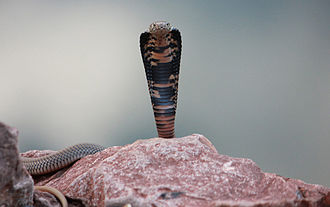
The Mozambique spitting cobra (Naja mossambica) is a highly venomous species of spitting cobra native to Africa. It is largely found at Angola, Botswana, Mozambique, Namibia, South Africa, Tanzania, Zambia and Zimbabwe.Description In color the snake is slate to blue, olive or tawny black above, with some or all scales black-edging. Below, salmon pink to purple yellowish, with black bars across the neck and ventrals speckled or edged with brown or black; young specimens sometimes have pink or yellow bars on the throat.The average length of adults is between 90 cm - 105 cm (3-3½ feet), but largest specimen actually measured was a male 154 cm (5 feet) long. (Durban, Kwa-Zulu Natal, South Africa]).Distribution This species is the most common cobra of the savanna regions of the tropical and subtropical Africa. The distribution includes KwaZulu-Natal, as far south as Durban, Mpumalanga Province Lowveld region, south-eastern Tanzania and Pemba Island and west to far southeastern Angola and northeastern Namibia. Younger specimens are much more frequently encountered in the open at daytime. Unlike the Egyptian Cobra, this species prefers localities near water, to which it will readily take when disturbed.Toxicology It is considered one of the most dangerous snakes in Africa. Its venom is about as toxic as the American Mojave rattlesnake, considered the world's most venomous rattlesnake. Like the rinkhals, it can spit its venom. Its bite causes severe local tissue destruction (similar to that of the puff adder). Venom to the eyes can also cause impaired vision or blindness.[4] The venom of this species contains postsynaptic neurotoxin and cytotoxin. There have been only a few fatalities resulting from bites of this species but survivors are mostly disfigured.
Puff Adder
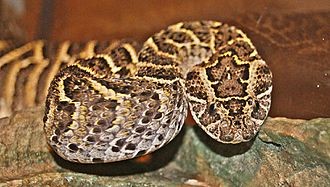
The puff adder (Bitis arietans) is a venomous viper species found in savannah and grasslands from Morocco and western Arabia throughout Africa except for the Sahara and rainforest regions.[2] It is responsible for causing the most snakebite fatalities in Africa owing to various factors, such as its wide distribution, frequent occurrence in highly populated regions, and aggressive disposition. The snake's typical size is about 1.0 m (39.3 in) in total length (body and tail) and very stout. Large specimens of 190 cm (75 in) total length, weighing over 6.0 kg (13.2 lb) and with a girth of 40 cm (16 in) have been reported. Specimens from Saudi Arabia are not as large, usually no more than 80 cm (31 in) in total length. Males are usually larger than females and have relatively longer tails.The color pattern varies geographically. The head has two well-marked dark bands - one on the crown and the other between the eyes. On the sides of the head, two oblique, dark bands or bars run from the eye to the supralabials. Below, the head is yellowish white with scattered dark blotches. Iris color ranges from gold to silver-gray. Dorsally, the ground color varies from straw yellow, to light brown, to orange or reddish brown. This is overlaid with a pattern of 18–22 backwardly directed, dark brown to black bands that extend down the back and tail. Usually, these bands are roughly chevron-shaped, but may be more U-shaped in some areas. They also form two to six light-and-dark cross-bands on the tail. Some populations are heavily flecked with brown and black, often obscuring other coloration, giving the animal a dusty-brown or blackish appearance. The belly is yellow or white, with a few scattered dark spots. Newborn young have golden head markings with pinkish to reddish ventral plates toward the lateral edges. One unusual specimen, described by Branch and Farrell (1988), from Summer Pride, East London, in South Africa, was striped. The pattern consisted of a narrow (one scale wide), pale yellowish stripe that ran from the crown of the head to the tip of the tail. Generally, though, these are relatively dull-looking snakes, except for male specimens from highland East Africa and the Western Cape province of South Africa, that usually have a striking yellow-and-black color pattern.
Rhombic Night Adder
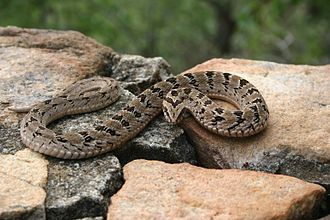
Causus rhombeatus, commonly known as the rhombic night adder, is a venomous viper species endemic to subsaharan Africa. No subspecies are currently recognized. With an average total length (body + tail) of 60 cm (24 in), this is the largest member of the genus Causus. The longest individual ever recorded was a male, 93 cm (37 in) in total length, collected in eastern Zimbabwe.[3]The head has a snout that is relatively blunt (i.e., more rounded than in other members of this genus), on the sides of which the nostrils are positioned. The circumorbital ring consists of 2-3 preoculars, 1-2 postoculars, and 1-2 suboculars that separate the eye from the supralabials. The temporal scales usually number 2+3, sometimes 2+4, but very rarely 2+2 or 3+3. There are 6 supralabial scales, very rarely 7. The sublabial scales usually number 7 or 10, rarely 8, and very rarely 11, 12 or 13. The first 3-4 sublabials are in contact with the anterior chin shields. The posterior chin shields are small and often indistinguishable from the gulars.[3]At midbody there are 15-21 rows of dorsal scales that are moderately keeled and have a satiny texture. The ventral scales number 120-166, the subcaudals, most of which are divided, 15-36.[3]The color pattern consists of a ground color that is usually some shade of brown (possibly pinkish or grayish-brown), but occasionally olive green. This is overlaid with a pattern of 20-30 rhombic blotches that have pale edges, as well as a sprinkling of black scales and oblique black bars on the sides.[4] Each oblique black bar is topped by one or two black spots, each with a pale centre, and strongly resembling an eye. Northern populations may be patternless,[3] making them difficult to identify, while in others the pale edges may be missing, the rhombic blotches may be a darker color, or there may even be a dark brown vertebral stripe. The head has a characteristic V-shaped mark that may be solid black, or brown with a black outline. Venom Rhombic Night Adder bites can be very serious and in at least one bite a child had to have a fasciotomy.[citation needed] The few documented bites involved pain and minor swelling with minimal necrosis. These symptoms usually disappear within 2–3 days. There have been no modern well-documented cases to back up earlier claims of fatalities due to bites from this species.[4] Venom yield has varied from 20–30 mg to 300 mg, but the venom toxicity is low with LD50 values of 10.8, 14.6, >16.0 mg/kg IV and 15 mg/kg SC being reported
Snouted Cobra
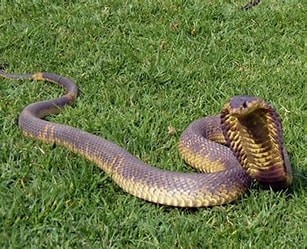
The snouted cobra (Naja annulifera), also called the banded Egyptian cobra, is a highly venomous species of cobra found in Southern Africa.The snouted cobra is a relatively large species. Adult specimens average between 1.2 and 1.8 metres (3.9 and 5.9 ft) in length, but they may reach lengths of 2.5 metres (8.2 ft). Colouration of dorsal scales may vary from yellowish to greyish-brown, dark brown or blue-black. Ventral scale colouration is yellow with darker mottles. A banded phase occurs throughout the species' range and is blue-black with 7-11 yellow to yellow-brown cross bars, the lighter bands being half the width of the darker bands. The latter colour phase is more common in males. Ventrally, it is yellow mottled with black. A darker throat band is present and is usually more prominent in juveniles.Scalation Midbody scales are in 19 rows (rarely 21) with 175-203 ventrals. There are 51-65 paired subcaudals and the anal shield is entire. There are seven (sometimes eight) upper labials that do not enter the eye, eight or 9 (rarely 10) lower labials, as well as one preocular (sometimes two) and two (sometimes one or three) postoculars. Temporals are variable.Distribution This species is found in northeast South Africa, southern Mozambique, eastern Botswana, Malawi, throughout Zimbabwe, and parts of Swaziland.Habitat and ecology Snouted cobras inhabit arid and moist savanna, particularly in bushveld and lowveld areas. It is not found in forests. As a large cobra, it often has a permanent home base or lair in an abandoned termite mound, where it will reside for years if left undisturbed. It is a nocturnal species, foraging for food from dusk onwards. It enjoys basking in the sun during the day near its lair or retreat. This species can be quite nervous and will strike to defend itself if threatened. Like other cobras, when disturbed, it usually raises the front-third of its body when extending its hood and hissing. Very large adults are able to lift as much as 0.5 m of the body off the ground while spreading a wide, impressive hood. However, given the opportunity, it will escape to the nearest hole or crevice. Like the rinkhals, it may sham death if threatened, but this is rare. It preys on toads, rodents, birds and their eggs, lizards and other snakes, especially puff adders (Bitis arietans). It often raids poultry runs and can become a nuisance. It is preyed upon by birds of prey and other snakes.Reproduction This is an oviparous species, laying between 8 and 33 eggs in early summer. The young average 22 to 34 cm (8.7 to 13.4 in) in length.[3]Taxonomy It was formerly considered a subspecies of the Egyptian cobra Naja haje, and the Anchieta's cobra (Naja anchietae) was also formerly considered to be a subspecies of the latter species and later this species, before being split as a distinct species.Venom It is a highly venomous species with neurotoxic venom. Intravenous LD50 value is 1.98 mg/kg.[5] A bite can affect breathing, and if left untreated, may cause respiratory failure and death. Initial symptoms include pain and local swelling that may result in blistering. Typically, victims are bitten on the lower leg, usually at night.
Spotted Bush Snake
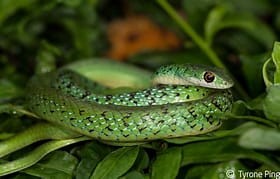
Philothamnus semivariegatus, commonly known as the spotted bush snake is a species of non-venomous colubrid snake, endemic to Africa. Description The colour is bright green with black speckles. Average snout to vent length (SVL) is 60–90 cm (24–35 in).Biology Spotted bush snakes are mostly found in trees in bush and forest areas, where they hunt lizards and treefrogs. They are excellent climbers and swimmers, have very good eyesight, and are highly alert snakes. They are not territorial, and will roam great distances in search for food. Spotted bush snakes are very common and completely harmless. They are well camouflaged, naturally very nervous, and quick to escape from any potential threat. As such, suburban sightings are rare.
Western Yellow Bellied Sand Snake
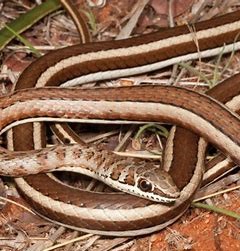
This snake is a long slender snake with a pointed head and round pupils, usually striped from neck to tail, although you can't really see the body in this photo. This is a very common and extremely fast moving snake. It is diurnal (active in daytime) like most sand/whip snakes. If stumbled upon, this snake will slither off quickly and then freeze within the nearest bush or shrub and futher rely on camouflage. This snake is largely terrestrial. It has a lemony-yellow coloured belly. The adults can reach lenghts up to 1.4 meters long.This snake can be found in the Northwest and Limpopo provinces and countries surrounding these areas. I favours arid savanna biomes. It is very common in the Limpopo valley as well as the Zambezi valley.This snake poses no danger to man, although it is mildly venomous. It feeds on rodents, frogs, lizzards and small birds. This snake can easily be confused with the other sand/whip snakes of the Genus Psammophis. Sometimes confused with the striped skaapsteker.Scale count at midbody would be in 17 rows with 155 to 181 ventral scales and 106 to 132 paired subcaudals. The anal shield is devided.
Twig (Vine) Snake
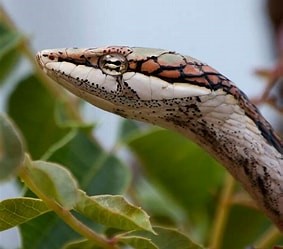
The twig snakes (genus Thelotornis), also commonly known as bird snakes or vine snakes, are a genus of rear-fanged venomous snakes in the family Colubridae. The genus is native to Africa. All species in the genus have a slender and elongated profile, a long tail, a narrow head, and a pointed snout. The eye of all species has a horizontal pupil, shaped like a keyhole, which gives twig snakes binocular vision. Twig snakes are greyish-brown with faint light and dark markings. When threatened, they inflate the throat to display bold black markings between the scales. Twig snakes are deadly: the venom is hemotoxic, affecting the blood clotting mechanism and causing uncontrolled bleeding and internal hemorrhaging.[2] Bites by twig snakes have caused death in humans; famous herpetologist Robert Mertens died after being bitten by his pet Savanna vine snake (Thelotornis capensis). However, envenomed bites are extremely rare when not handling the snake, as the fangs can't reach the skin except in a few places like the web between the thumb and fingers. The African twig snakes are distinctive in appearance and unlikely on that continent to be mistaken for any other snake, if indeed the observer notices them. Thelotornis is characterised by a depressed and flat head, keyhole-shaped pupils, and in T. kirtlandii, a projecting canthus rostralis which forms a shallow loreal groove on each side of the head, which allows some binocular vision. In appearance, the head at least is unlikely to be mistaken for any other African snake. Other characteristics include a very long tail and large back fangs. The iris in T. capensis and T. kirtlandii is yellow, and presumably therefore also in T. usambaricus.
